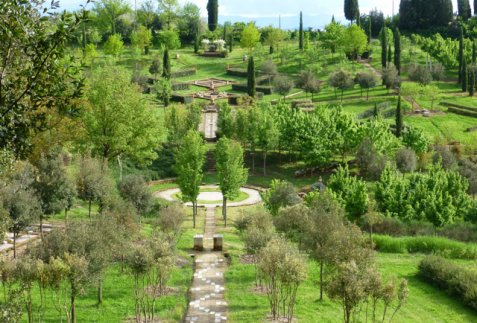Italy again - the copy below first appeared in IntoGardens, the on-line gardening app. It gives a quick overview of 10 gardens in Italy that I love. Five are very old and five are from the 20th century. 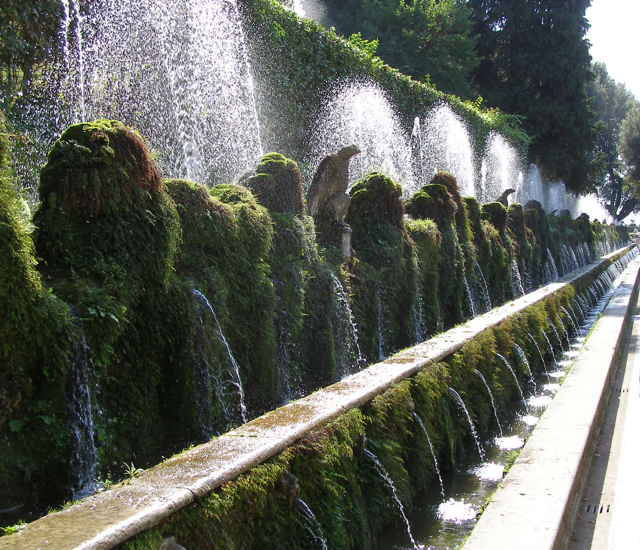 Villa d’Este a Tivoli, Lazio: Ippolito (Hercules to you and me) d’Este, son of Lucrezia Borgia and the richest cardinal in Rome, had high papal ambitions. Thwarted in this and made up as governor of dusty Tivoli in 1560, he turned the glare of his intellectual beam and his wallet on his garden. Antiquarians and hydrologists were summoned. Aqueducts were built, tributaries re-channelled and Hadrian’s VIlla in the valley below raided for statues and mosaics. Tivoli was on a hill, but knocking down half the town in the process he provided the townspeople with clean drinking water and himself with an orgasmic collection of fountains, jets over 12 metres high playing into the air in synchro and all without a pump. The d’Este gardens are richly peppered with allegory and classical references but the main thing is showing off on a jaw-dropping and fabulous scale. It is no surprise that the place has been made into a World Heritage Site.
Villa d’Este a Tivoli, Lazio: Ippolito (Hercules to you and me) d’Este, son of Lucrezia Borgia and the richest cardinal in Rome, had high papal ambitions. Thwarted in this and made up as governor of dusty Tivoli in 1560, he turned the glare of his intellectual beam and his wallet on his garden. Antiquarians and hydrologists were summoned. Aqueducts were built, tributaries re-channelled and Hadrian’s VIlla in the valley below raided for statues and mosaics. Tivoli was on a hill, but knocking down half the town in the process he provided the townspeople with clean drinking water and himself with an orgasmic collection of fountains, jets over 12 metres high playing into the air in synchro and all without a pump. The d’Este gardens are richly peppered with allegory and classical references but the main thing is showing off on a jaw-dropping and fabulous scale. It is no surprise that the place has been made into a World Heritage Site. 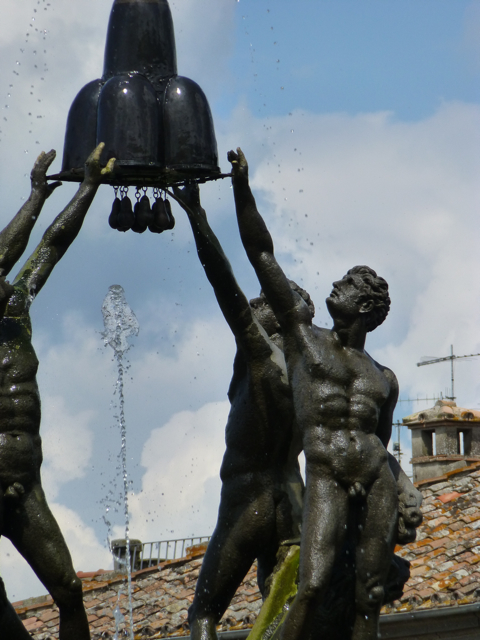 Villa Lante, Lazio: In 16th century Italy, cardinals, the richest in the land, used their money to make gardens. The gain was two-fold: they gave themselves a pleasurable retreat and at the same time a status symbol with knobs on. Villa Lante, the creation of Cardinal Gambara has been vaunted for centuries as the perfect Italian Renaissance garden. And so it is. Completely and utterly harmonious. There are views out over the town, steep slopes terraced, sharp shade, still and running water and elegant pavilions, statuary and the inevitable clipped box. Throughout, carvings and sculptings of scuttling claws - a play on his name which translates to prawn. The cardinal already had a house in town and the brief for the garden was as a place for picnics. Above the two pavilions there is a stone table with a water channel rippling down the middle for the cooling of wine bottles. It is an urbane garden, not too big but made interesting by the fact that it cannot be seen as a whole from any single place.
Villa Lante, Lazio: In 16th century Italy, cardinals, the richest in the land, used their money to make gardens. The gain was two-fold: they gave themselves a pleasurable retreat and at the same time a status symbol with knobs on. Villa Lante, the creation of Cardinal Gambara has been vaunted for centuries as the perfect Italian Renaissance garden. And so it is. Completely and utterly harmonious. There are views out over the town, steep slopes terraced, sharp shade, still and running water and elegant pavilions, statuary and the inevitable clipped box. Throughout, carvings and sculptings of scuttling claws - a play on his name which translates to prawn. The cardinal already had a house in town and the brief for the garden was as a place for picnics. Above the two pavilions there is a stone table with a water channel rippling down the middle for the cooling of wine bottles. It is an urbane garden, not too big but made interesting by the fact that it cannot be seen as a whole from any single place. 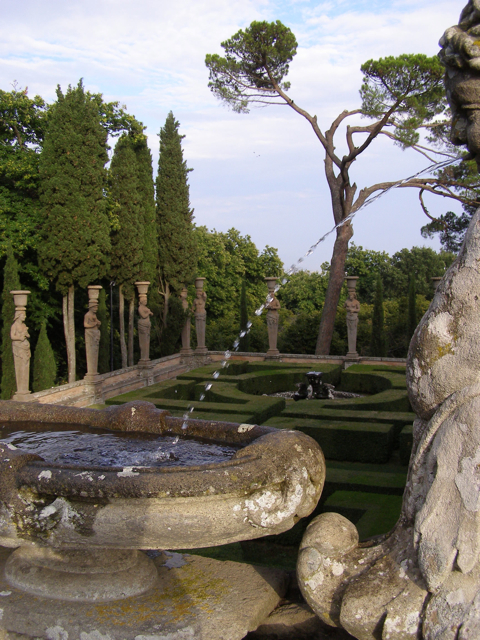 Palazzo Farnese, Caprarola, Lazio: The timorous town of Caprarola is dominated by a pentagon shaped fortress built way back by the Farnese to control their land gains throughout the province of Lazio. In 1559 Alexander Farnese, grandson of a pope and a cardinal from the age of 14, inherited here. Alexander was a collector of books, maps, gems and had the ‘stone disease’. In short, he was addicted to architectural renovation. Fortress softened, he and architect Viganelllo had work to do in the gardens. These are hidden away above the palazzo, approached up a long path through trees. It is all a little bit shabby and when the guide turns the switches to bring the cascade of water flowing out of giant cornucopias and down a basin of linked dolphins, all is stop and start. In that lies its charm for the place is under-visited and you can imagine the cardinal entertaining in his Lodge of Pleasure up at the top looking out over caryatids and fluting water jets, blessing himself for the escape from the heat of Rome.
Palazzo Farnese, Caprarola, Lazio: The timorous town of Caprarola is dominated by a pentagon shaped fortress built way back by the Farnese to control their land gains throughout the province of Lazio. In 1559 Alexander Farnese, grandson of a pope and a cardinal from the age of 14, inherited here. Alexander was a collector of books, maps, gems and had the ‘stone disease’. In short, he was addicted to architectural renovation. Fortress softened, he and architect Viganelllo had work to do in the gardens. These are hidden away above the palazzo, approached up a long path through trees. It is all a little bit shabby and when the guide turns the switches to bring the cascade of water flowing out of giant cornucopias and down a basin of linked dolphins, all is stop and start. In that lies its charm for the place is under-visited and you can imagine the cardinal entertaining in his Lodge of Pleasure up at the top looking out over caryatids and fluting water jets, blessing himself for the escape from the heat of Rome. 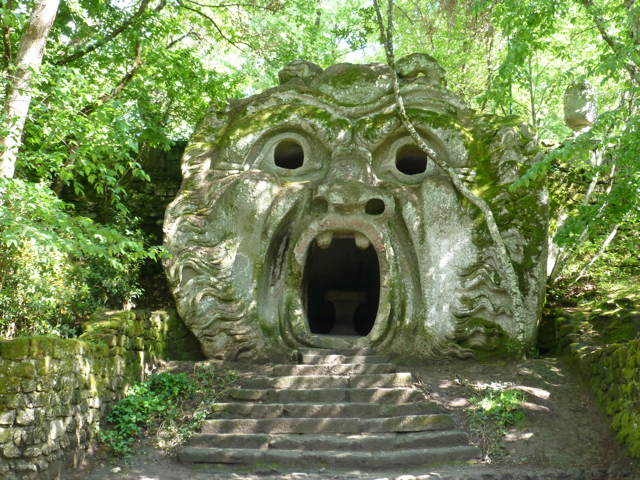 Il Sacro Bosco, Lazio: The Sacro Bosco is full of weird over-sized figures - monster, human and abstract carved out of tufa at the bottom of a ravine below Bomarzo, a small town in Lazio. There are dragons, an elephant, a woman riding on a tortoise. The work was commissioned by Victor Orsini, whose wife’s cousin was Alexander the cardinal over at Caprarola. Small world, different taste, for the bizarre figures and their random distribution are the antithesis of Renaissance ideals of composition, design or harmony. Perhaps he was having a joke - for instance there is a scaled down house on a wonk that throws dust at rules of perspective but then there is tell that the inspiration was Ariosto’s Orlando Furiosa. At Orsini’s death his park of monsters became an embarrassment and reverted to brambles. Left untouched until 1949. Salvador Dali visited and loved it. Since then it is back on the map and if you visit you will either love or hate it.
Il Sacro Bosco, Lazio: The Sacro Bosco is full of weird over-sized figures - monster, human and abstract carved out of tufa at the bottom of a ravine below Bomarzo, a small town in Lazio. There are dragons, an elephant, a woman riding on a tortoise. The work was commissioned by Victor Orsini, whose wife’s cousin was Alexander the cardinal over at Caprarola. Small world, different taste, for the bizarre figures and their random distribution are the antithesis of Renaissance ideals of composition, design or harmony. Perhaps he was having a joke - for instance there is a scaled down house on a wonk that throws dust at rules of perspective but then there is tell that the inspiration was Ariosto’s Orlando Furiosa. At Orsini’s death his park of monsters became an embarrassment and reverted to brambles. Left untouched until 1949. Salvador Dali visited and loved it. Since then it is back on the map and if you visit you will either love or hate it. 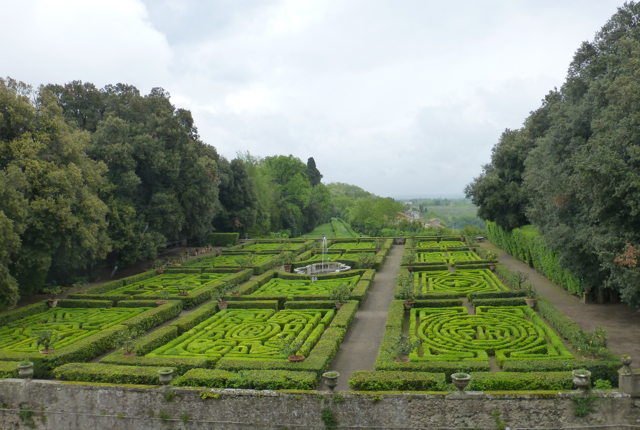 Castello Ruspoli, Lazio: There comes a time when you may feel parterred to death but the massive scrollings of box at Castello Ruspoli will make you think again. This is the best preserved Renaissance one in Italy and it is so impressive in the green that I completely forgot to pace it out for dimensions. Let me tell you that you cross a drawbridge to get to the garden and way down below are the tops of cars and washing lines. Beyond that the deer park, or what remains of it. The Marescotti, who have lived there for centuries and have a house full of fabulous family snaps of their rellies (Prince Marescotti Ruspoli as hereditary papal chamberlain in ruff, britches and eye patch escorting tiara-ed royalty into the Vatican) hand stenciled wallpaper, family chapel and old creaking leather furniture. The garden was laid out by the daughter of the Orsini who made Il Sacro Bosco. A plaque commemorates this. The date? 1611.
Castello Ruspoli, Lazio: There comes a time when you may feel parterred to death but the massive scrollings of box at Castello Ruspoli will make you think again. This is the best preserved Renaissance one in Italy and it is so impressive in the green that I completely forgot to pace it out for dimensions. Let me tell you that you cross a drawbridge to get to the garden and way down below are the tops of cars and washing lines. Beyond that the deer park, or what remains of it. The Marescotti, who have lived there for centuries and have a house full of fabulous family snaps of their rellies (Prince Marescotti Ruspoli as hereditary papal chamberlain in ruff, britches and eye patch escorting tiara-ed royalty into the Vatican) hand stenciled wallpaper, family chapel and old creaking leather furniture. The garden was laid out by the daughter of the Orsini who made Il Sacro Bosco. A plaque commemorates this. The date? 1611. 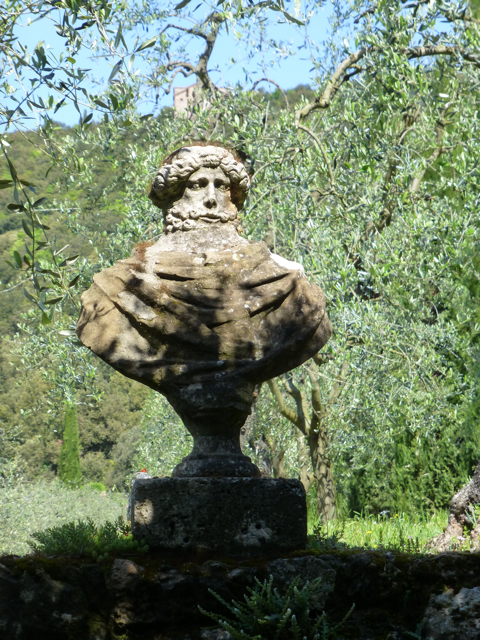 Villa Cetinale, Tuscany: Villa Cetinale is, In the words of Penelope Hobhouse ‘one of the most beautiful flower gardens in Italy”. And she is right. It belonged to the Chigi Sienese banking family for hundreds of years and is begirt by old walls, sloping hills of twisty oaks and overlooked by a hermitage perched on a high incline. There are the remnants of tracks where the Sienese horse race, the Palio were run. The walls were crumbling, vandalism was rife and the place was getting ruinous. In 1977 the Lambton family bought the house and land. The restoration of the garden began and now there is a lovely fusion of the Italian evergreen bones of the site - of which the tunnels of Quercus ilex which make the sun split, shiver and dance, are the most incredible. These elements of classical good breeding are married up with plantings of of roses, agapanthus, rosemary and irises. Wisteria with the girth of a boa constrictor twines round the walls. It is a breathtakingly beautiful place.
Villa Cetinale, Tuscany: Villa Cetinale is, In the words of Penelope Hobhouse ‘one of the most beautiful flower gardens in Italy”. And she is right. It belonged to the Chigi Sienese banking family for hundreds of years and is begirt by old walls, sloping hills of twisty oaks and overlooked by a hermitage perched on a high incline. There are the remnants of tracks where the Sienese horse race, the Palio were run. The walls were crumbling, vandalism was rife and the place was getting ruinous. In 1977 the Lambton family bought the house and land. The restoration of the garden began and now there is a lovely fusion of the Italian evergreen bones of the site - of which the tunnels of Quercus ilex which make the sun split, shiver and dance, are the most incredible. These elements of classical good breeding are married up with plantings of of roses, agapanthus, rosemary and irises. Wisteria with the girth of a boa constrictor twines round the walls. It is a breathtakingly beautiful place. 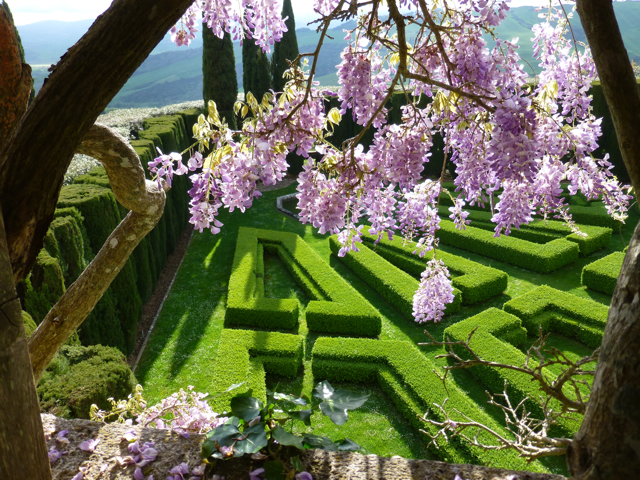 La Foce, Tuscany: “War in the Val d’Orcia” is the book about the valley that Iris Origo and her husband bought and reclaimed. Cultivated out of the roughest, poorest driest land for their tenant farmers and themselves. It is also, of course, the story of the war. It tore that remote valley apart. Nature bounces back and survives and that includes the garden of La Foce, the large farmhouse that the family still lives in. Iris describes the making of the garden which must have been a labour of love. To start off with they had no water and its installation waited on an inheritance. Designed by Cecil Pinsent in 1927, the gardens are restrained and bow and take their hat off to the view. There is a stunningly tall wall over which the Rosa banksaie and the wisteria romp. The stone and hedge layout has a little whiff of the fascist. There are linear metres of box and lemon trees in hefty pots. Iris and peonies for the early summer and slopes of wild flowers which lead down to the small family cemetery.
La Foce, Tuscany: “War in the Val d’Orcia” is the book about the valley that Iris Origo and her husband bought and reclaimed. Cultivated out of the roughest, poorest driest land for their tenant farmers and themselves. It is also, of course, the story of the war. It tore that remote valley apart. Nature bounces back and survives and that includes the garden of La Foce, the large farmhouse that the family still lives in. Iris describes the making of the garden which must have been a labour of love. To start off with they had no water and its installation waited on an inheritance. Designed by Cecil Pinsent in 1927, the gardens are restrained and bow and take their hat off to the view. There is a stunningly tall wall over which the Rosa banksaie and the wisteria romp. The stone and hedge layout has a little whiff of the fascist. There are linear metres of box and lemon trees in hefty pots. Iris and peonies for the early summer and slopes of wild flowers which lead down to the small family cemetery. 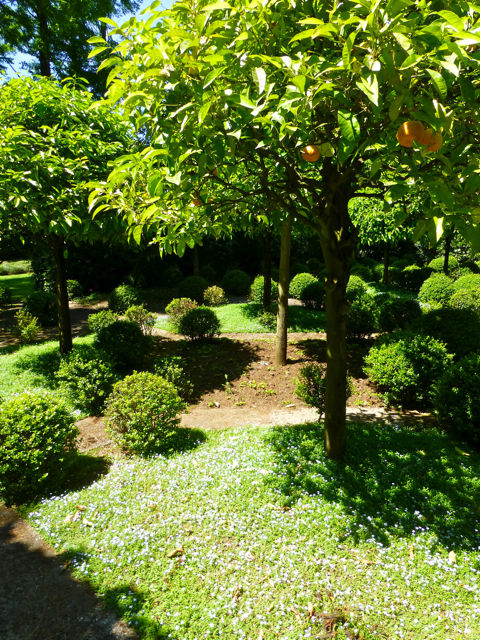 La Landriana, Ardea, Lazio: Near the saggy, tideless beaches of the Anzio landings there is garden that the Marchesa Lavinia Turner nurtured out of a mine-strewn landscape. Called La Landriana and made with the help and guidance of Russell Page. The Marchesa was a plantaholic and Page, as restraining landscape architect helped design the garden and oversee the planting. Their collaboration has created a soft and rather English garden which is going a little blurry round the edges since her death some ten years ago. There are one or two bits of gardening or planting that I carried away as perfect - one is the treatment of the olive trees which get pruned hard to keep them getting too gawky, second is the iconic Page thing of the box balls under the orange trees. Best of all is the whole hillside of Rosa Mutabilis. Oh for a whole hillside to run away with.
La Landriana, Ardea, Lazio: Near the saggy, tideless beaches of the Anzio landings there is garden that the Marchesa Lavinia Turner nurtured out of a mine-strewn landscape. Called La Landriana and made with the help and guidance of Russell Page. The Marchesa was a plantaholic and Page, as restraining landscape architect helped design the garden and oversee the planting. Their collaboration has created a soft and rather English garden which is going a little blurry round the edges since her death some ten years ago. There are one or two bits of gardening or planting that I carried away as perfect - one is the treatment of the olive trees which get pruned hard to keep them getting too gawky, second is the iconic Page thing of the box balls under the orange trees. Best of all is the whole hillside of Rosa Mutabilis. Oh for a whole hillside to run away with. 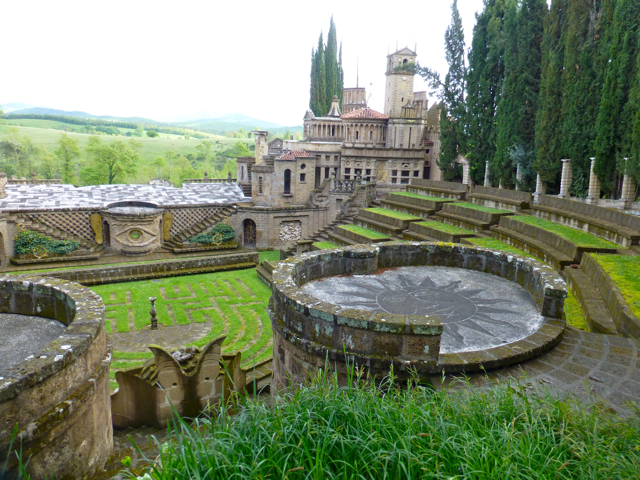 La Scarzuola, Umbria: Tomaso Buzzi - who he? Back in the 1930s he was the darling of the cocktail shaking crowd. After graduating in architecture from Milan Polytechnic College he designed glass for Vetrini, furniture in assocation with Gio Ponti and became the man to design the interior of the glizziest mansions. In 1957 he bought a small Franciscan chapel and the land around it in a hidden valley in Umbria complete with the spring from which St Francis drank. Imagination unfettered, he began building a scaled down town, Portmerion style. Buzzi defined it as a “theatrical complex” - there are 7 theatres with size diminuishing so the smallest can only seat 3. The play with scale is charming and forbidding in the same glance. A huge headless female torso, a tiny Acropolis not to mention the Tower of Babel, pagan temples, meditation grottoes and the Arc du Triomphe. All of this is set in a natural amphitheatre which just about rescues the visitor from the discombobulation of staircases leading nowhere and the puzzling warp of scale and size.
La Scarzuola, Umbria: Tomaso Buzzi - who he? Back in the 1930s he was the darling of the cocktail shaking crowd. After graduating in architecture from Milan Polytechnic College he designed glass for Vetrini, furniture in assocation with Gio Ponti and became the man to design the interior of the glizziest mansions. In 1957 he bought a small Franciscan chapel and the land around it in a hidden valley in Umbria complete with the spring from which St Francis drank. Imagination unfettered, he began building a scaled down town, Portmerion style. Buzzi defined it as a “theatrical complex” - there are 7 theatres with size diminuishing so the smallest can only seat 3. The play with scale is charming and forbidding in the same glance. A huge headless female torso, a tiny Acropolis not to mention the Tower of Babel, pagan temples, meditation grottoes and the Arc du Triomphe. All of this is set in a natural amphitheatre which just about rescues the visitor from the discombobulation of staircases leading nowhere and the puzzling warp of scale and size. 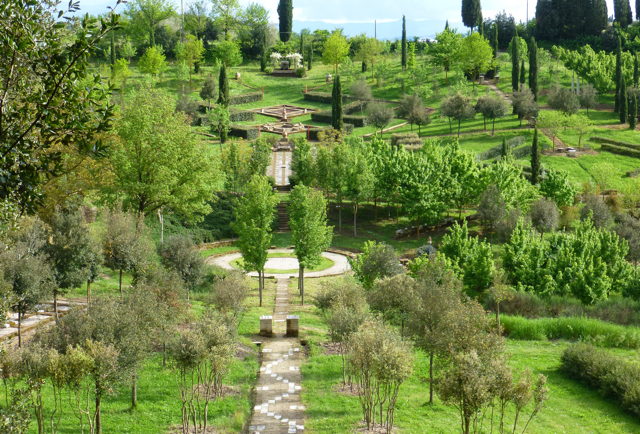 La Ragnaia, Tuscany: Il Bosco della Ragnaia as a space or garden is a always open to the public and no charge is made. Only one rule, don’t smoke. Sheppard Craig has a woodland garden where the trees have been carefully felled, as feels right. Walk through this and the second half of his site is a sunny bowl of a field with red posts, site-lined paths and many statues made by his wife. You would be hard-pushed to find a more engaging and grounded gardener. He started out by going into the village bar and persuading bored teenagers off the fruit machines and out to help him clear, create, plant. And the villagers are welcome to treat the space as their own. There they were sitting on benches in the sun, drinking in nature. It is a magical spot. All the above gardens are not too many miles drive from Rome's Ciampino airport in the provinces of Lazio, Umbria and Tuscany. Linking the gardens up to open to fit in with your itinerary is as big a nightmare as the gardens are lovely. Car hire is easy but distances are great and roads wind into steep hills. A minibus equipped with a driver is how I prefer to organise the bespoke tours that I occasionally lead. The best way to put together a good plan for visiting gardens in Italy is to get on the telephone. (Take a deep breath and pray that they speak English). Websites are glossy but muddly. It is extremely unusual for a garden to be open on a daily or even frequent basis. Only half on my list are open regularly. There is a strong culture of the booked guided tour and then pot luck: a taciturn guide who remains silent and rattles his car keys in his pockets or one who simply speaks too much and makes you want to cry.
La Ragnaia, Tuscany: Il Bosco della Ragnaia as a space or garden is a always open to the public and no charge is made. Only one rule, don’t smoke. Sheppard Craig has a woodland garden where the trees have been carefully felled, as feels right. Walk through this and the second half of his site is a sunny bowl of a field with red posts, site-lined paths and many statues made by his wife. You would be hard-pushed to find a more engaging and grounded gardener. He started out by going into the village bar and persuading bored teenagers off the fruit machines and out to help him clear, create, plant. And the villagers are welcome to treat the space as their own. There they were sitting on benches in the sun, drinking in nature. It is a magical spot. All the above gardens are not too many miles drive from Rome's Ciampino airport in the provinces of Lazio, Umbria and Tuscany. Linking the gardens up to open to fit in with your itinerary is as big a nightmare as the gardens are lovely. Car hire is easy but distances are great and roads wind into steep hills. A minibus equipped with a driver is how I prefer to organise the bespoke tours that I occasionally lead. The best way to put together a good plan for visiting gardens in Italy is to get on the telephone. (Take a deep breath and pray that they speak English). Websites are glossy but muddly. It is extremely unusual for a garden to be open on a daily or even frequent basis. Only half on my list are open regularly. There is a strong culture of the booked guided tour and then pot luck: a taciturn guide who remains silent and rattles his car keys in his pockets or one who simply speaks too much and makes you want to cry.
